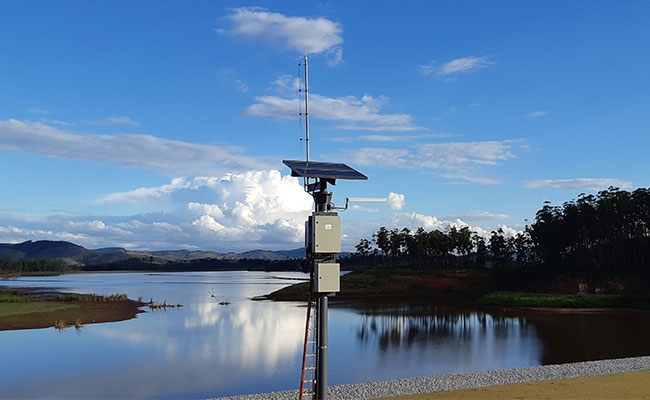Microseismic Technology for Tailings Dams Monitoring
Monitoring the structural stability of tailings dams and identifying parameters that may cause failure
Published 10-07-20
Submitted by Tetra Tech

Tetra Tech Geologists, Camilla Rodrigues and Lorena Oliveira, discuss the microseismic technology we developed to help assess and mitigate risks for tailings dams.
This article originally ran in International Water Power & Dam Construction magazine.
The monitoring of dam safety, including identifying and minimizing geotechnical risks, is a challenge faced by geotechnical engineers, especially in the mining and water supply industries. Microseismic technology provides a continuous solution for the monitoring of geotechnical structures.
Tailings dams are some of the most challenging structures for geotechnical engineers to manage due to the following:
- A dam’s body construction is often built with residual materials from mining operations
- The continuous production of tailings requires successive dam raisings
As a result, it is estimated that the failure rates of tailings dams are 100 times higher than other dams.1
On a global scale, tailings dam failures are becoming more frequent, causing significant damage to the environment and loss of life. To mitigate these catastrophic events in the future, Tetra Tech developed a microseismic technology that can monitor the structural stability of tailings dams and identify parameters that may lead to failure.
Microseismic Technology
Tetra Tech signed a partnership with the Institute of Mine Seismology in Australia to develop an innovative technology to be applied in the monitoring of tailings dams in Brazil. We have installed this technology in more than 20 mining dams on an operational scale of 24/7 monitoring regime.
Tetra Tech’s microseismic technology uses one array with multiple possibilities. Based on two monitoring approaches—conventional seismic monitoring and the innovative seismic ambient noise interferometry—the technology continuously monitors internal changes in a structure, using ground motions and seismic wave velocity propagation, which is a media property.
The physical properties of a microseismic monitoring system are the same as those applied in a traditional seismic system. The difference is the equipment’s sensitivity. The employed geophones can record the ground motions with high sensitivity, with a magnitude higher than -2 (considering seismic moment), called microseisms, while a conventional seismic system registers events with magnitude more than zero.
Additionally, the technology is based on a complex architecture. The installation stage is responsible for ensuring data quality. Due to the high sensitivity of sensors and low theoretical error, uncertainty associated with the installation can overcome the method’s uncertainty. Thus, this stage is critical for the monitoring system success.
The installed system is composed of high sensitivity geophones, analog-to-digital signal converters, and pre-processing sensors. The data is recorded by these sensors and is sent to a seismic server to be processed and analyzed, using two different monitoring approaches.
The conventional approach is based on the registration of ground motions that exceed the sensors’ threshold sensitivity. The occurrence of simultaneous triggers in three or more geophones creates a seismic event. For each event registered, the system calculates source parameters, such as magnitude and location. Such parameters can support the estimation of a ground motion prediction equation that can estimate ground motions for a given energy—or potency—and distance. Therefore, this approach provides measured ground motion data on the monitored structures and supports the prediction of ground motions for simulated events, such as mine blasts.
The second approach is a new methodology called seismic ambient noise interferometry. This method measures the seismic wave propagation velocity change rate—the 24/7 monitoring regime—throughout the medium. This parameter is related to stiffness and specific mass, which are, in turn, related to pore pressure, fracturing, deformation, and loading. Therefore, anomalous behavior could be identified with high sensitivity, creating real-time data for geotechnical engineers to make information-based decisions.
Tailings Dams Monitoring
Following the necessity of new technologies to increase the level of monitoring of tailings dams, coupled with the failures of November 2015 and January 2019, Brazilian miners invested in geophysical methods to investigate dam conditions through imaging inside the structure and 24/7 microseismic continuous monitoring to detect possible risks to the dam physical integrity.
Since 2018, Tetra Tech has commissioned more than 20 systems and installed more than 180 geophones connected to 50 seismic stations. Most of the systems are in Minas Gerais state, the Brazilian mining capital.
These systems are continuously processing collected data to support the safety of miners and dams in multiple locations and ground conditions. They provide an extensive data flow to identify early warnings about the integrity of tailings dams and allows the geotechnical engineers to remotely monitor each dam’s structural stability and mitigate instabilities.
Leading with Science®
The convergence of geophysics, geology, and geotechnics in a multidisciplinary framework is essential in the analysis of dam conditions and highlights the need of intervention to support engineering works. Therefore, in addition to the microseismic method, Tetra Tech operates on other front lines, treating geophysics as an integrative science, to evaluate and investigate geotechnical structures.
Our applied geophysics group also works on geophysical-geotechnical interpretation, always seeking to give meaning to the geophysical data. Through shallow geophysical methods, it is possible to assess the safety of the structure, identify points of attention, and analyze its hydrogeological behavior.
In addition, with the use of conventional geophones, it is possible to characterize anthropogenic seismic sources, quantify generated vibration, and analyze how it attenuates or amplifies in the medium. With such information, it is possible to point out which operational activities can act as instability factors on the structures.
Finally, using numerical modeling to consider the physical properties of the medium within a geological structural context, we can simulate seismic sources, such as hypothetical ruptures or blasts, and predict how the ground motions induced by these blasts would propagate in the medium and reach geotechnical structures.
By Leading with Science, Tetra Tech focuses on providing our clients with the technology, tools, and innovative solutions to address the dangers of inadequate geotechnical behavior within tailings dams to improve safety in the mining industry.

Tetra Tech
Tetra Tech
Tetra Tech is a leading provider of high-end consulting and engineering services for projects worldwide. With 27,000 associates working together, Tetra Tech provides clear solutions to complex problems in water, environment, sustainable infrastructure, renewable energy, and international development. We are Leading with Science® to provide sustainable and resilient solutions for our clients. For more information about Tetra Tech, please visit tetratech.com or follow us on LinkedIn and Facebook.
More from Tetra Tech

